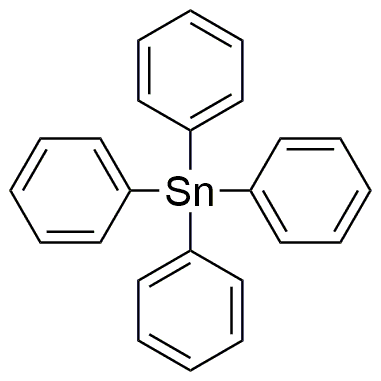Tetraphenyltin is widely utilized in research focused on:
- Organometallic Chemistry: It serves as a key reagent in synthesizing various organometallic compounds, facilitating the development of new materials and catalysts.
- Polymer Chemistry: Used as a stabilizer in the production of polymers, it enhances thermal stability and mechanical properties, making it valuable in the plastics industry.
- Electronics: Its unique properties make it suitable for applications in semiconductor technology, particularly in the fabrication of electronic components.
- Pharmaceuticals: It plays a role in drug formulation, where it can improve the solubility and bioavailability of certain compounds, aiding in more effective drug delivery systems.
- Environmental Science: Tetraphenyltin is studied for its potential applications in pollution remediation, particularly in removing heavy metals from contaminated sites.
General Information
Properties
Safety and Regulations
Applications
Tetraphenyltin is widely utilized in research focused on:
- Organometallic Chemistry: It serves as a key reagent in synthesizing various organometallic compounds, facilitating the development of new materials and catalysts.
- Polymer Chemistry: Used as a stabilizer in the production of polymers, it enhances thermal stability and mechanical properties, making it valuable in the plastics industry.
- Electronics: Its unique properties make it suitable for applications in semiconductor technology, particularly in the fabrication of electronic components.
- Pharmaceuticals: It plays a role in drug formulation, where it can improve the solubility and bioavailability of certain compounds, aiding in more effective drug delivery systems.
- Environmental Science: Tetraphenyltin is studied for its potential applications in pollution remediation, particularly in removing heavy metals from contaminated sites.
Documents
Safety Data Sheets (SDS)
The SDS provides comprehensive safety information on handling, storage, and disposal of the product.
Product Specification (PS)
The PS provides a comprehensive breakdown of the product’s properties, including chemical composition, physical state, purity, and storage requirements. It also details acceptable quality ranges and the product's intended applications.
Certificates of Analysis (COA)
Search for Certificates of Analysis (COA) by entering the products Lot Number. Lot and Batch Numbers can be found on a product’s label following the words ‘Lot’ or ‘Batch’.
*Catalog Number
*Lot Number
Certificates Of Origin (COO)
This COO confirms the country where the product was manufactured, and also details the materials and components used in it and whether it is derived from natural, synthetic, or other specific sources. This certificate may be required for customs, trade, and regulatory compliance.
*Catalog Number
*Lot Number
Safety Data Sheets (SDS)
The SDS provides comprehensive safety information on handling, storage, and disposal of the product.
DownloadProduct Specification (PS)
The PS provides a comprehensive breakdown of the product’s properties, including chemical composition, physical state, purity, and storage requirements. It also details acceptable quality ranges and the product's intended applications.
DownloadCertificates of Analysis (COA)
Search for Certificates of Analysis (COA) by entering the products Lot Number. Lot and Batch Numbers can be found on a product’s label following the words ‘Lot’ or ‘Batch’.
*Catalog Number
*Lot Number
Certificates Of Origin (COO)
This COO confirms the country where the product was manufactured, and also details the materials and components used in it and whether it is derived from natural, synthetic, or other specific sources. This certificate may be required for customs, trade, and regulatory compliance.


